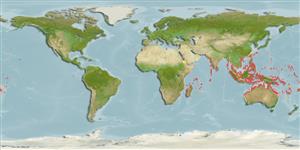Common names from other countries
Environment: milieu / climate zone / depth range / distribution range
Ecologie
Rifbewoner; diepteverspreiding 2 - 20 m (Ref. 98471). Tropical; 28°N - 34°S, 27°E - 170°W (Ref. 846)
Indo-Pacific. Tropical to subtropical.
Length at first maturity / Size / Gewicht / Leeftijd
Maturity: Lm ? range ? - ? cmCommon length : 9.9 cm DL mannelijk/geslacht niet bekend; (Ref. 269)
Colonies are formed of thick encrustations that develop atout (usually less than 10 cm in diameter), vertical, irregulary shaped branches, depending on exposure to wave action. May dominate wave-washed communities due to its solid construction. Axial corallites are difficult to distinguish due to the large area of branch tip. Many colonies consist of less than 12 main branches (Ref. 269).
Life cycle and mating behavior
Geslachtsrijpheid | Voortplanting | Kuitschieten | Eieren | Fecundity | Larven
Hermaphroditic (Ref. 113712). Mature gametes are shed into the coelenteron and spawned through the mouth. Life cycle: The zygote develops into a planktonic planula larva. Metamorphosis begins with early morphogenesis of tentacles, septa and pharynx before larval settlement on the aboral end (Ref. 833).
Hodgson, G. 1998. (Ref. 269)
Status op de Rode Lijst van het IUCN (Ref. 130435: Version 2024-1)
Status bij CITES (Ref. 108899)
Not Evaluated
Gebruik door de mens
| FishSource |
Tools
Meer informatie
Leeftijd/GrootteGroeiLengte-gewicht parametersLengte-lengte parametersMorfologieLarvenAbundantie
Internet-bronnen
Estimates based on models
Preferred temperature
(Ref.
115969): 24.7 - 29.3, mean 28.5 (based on 3296 cells).
Prijsklasse
Unknown.
